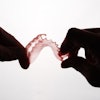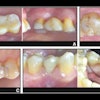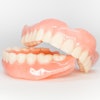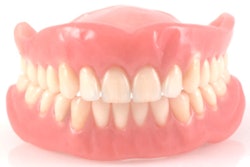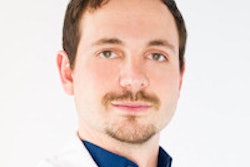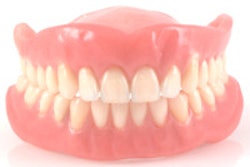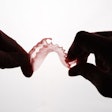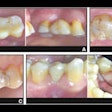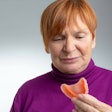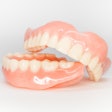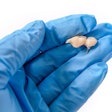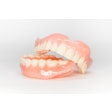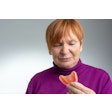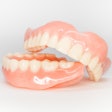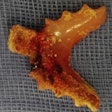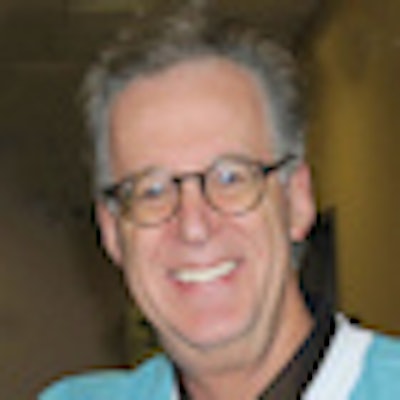
When Lawrence Wallace, DDS, first approached Terry Dickinson, DDS, director of the Virginia Dental Association and founder of Missions of Mercy (MOM), to demonstrate his one-hour denture technique, Dr. Dickinson was, as he puts it, "reticent."
"I was hesitant at first," he said. "It didn't make sense that you could make dentures in that short period of time. But I got a prosthodontist friend of mine to try them, and he said he thought these dentures would have a place in the missions."
Two years later, that's exactly what is driving the growth of Larell Dentures, Dr. Wallace's commercial denture venture.
Dr. Wallace, an oral and maxillofacial surgeon who practiced in Chicago for 25 years before back problems forced him to retire, developed the one-hour denture system to help the growing number of people across the U.S. who have been unable to afford dental care due to the economy, making it difficult for thousands of edentulous to obtain dentures.
 Dr. Lawrence Wallace (right) with patients who were recently fitted with Larell one-hour dentures. Image courtesy of Dr. Wallace.
Dr. Lawrence Wallace (right) with patients who were recently fitted with Larell one-hour dentures. Image courtesy of Dr. Wallace."In my 25 years as an oral surgeon, I saw firsthand the devastating effects of edentulism -- financially, emotionally, and physically," he said during a presentation at the 2011 ADA meeting.
The Larell system, first developed in 2003, features a set of customizable thermoplastic templates (upper and lower) in various sizes made from ADA- and FDA-approved materials.
The practitioner first makes a quick-set stone model of the jaws, then selects the preformed acrylic template with the closest fit based on the size of the patient's alveolar edentulous ridge. After heating the template in boiling water for 30 seconds, the practitioner can mold it to the palate, adjust as needed, then reline as for any denture. The process is repeated for the lower.
To adjust for occlusion, the practitioner checks the vertical dimension with the patient in a standing, relaxed position. The final vertical should be the standard 2 mm less than the initial measurement, according to Dr. Wallace.
Over the last two years, the use of the Larell One Step Denture system has expanded dramatically, Dr. Wallace recently told DrBicuspid.com. It is endorsed by America's Dentist Care Foundation, which sponsors MOM clinics across the U.S., and Remote Area Medical is adopting the technique into its clinics as well. Larell is also used by the U.S. Department of Veterans Affairs in some of its hospitals and nursing homes, Dr. Wallace noted.
"We've expanded into multiple states through the MOM events," he said. "We are doing so many MOMs, we are looking to train more dentists."
The company will only sell the Larell kit to dentists who have taken their training courses, Dr. Dickinson noted, adding that in many cases the training takes place during MOM events.
"You have to experience it with a patient, and at the clinics they can do it under the supervision of trainers over two days," he said. "You can't just watch the video and think you can do it. Hands-on training is critical."
Expanding market
Dr. Wallace is also spreading the word about the one-hour dentures through lectures and demonstrations at several dental meetings. In addition to the 2013 Chicago Midwinter Meeting last month, he is slated to give a presentation at the Virginia Dental Association meeting in September and a three-hour lecture plus two three-hour live demonstrations at the ADA Annual Session in October. He has also been invited to do a presentation for Dr. Gordon Christensen at his Utah facility next month.
Efforts are under way to get the Larell method added to the curriculum of several dental schools as well, Dr. Wallace noted, and the company is in the process of signing agreements with two key distribution companies.
“These dentures have had an amazing impact on an amazing number of people.”
Missions of Mercy
"We are also expanding our commercial sales through webinars and training seminars," he said. "Dentists are seeing that, with the economy, Larell dentures can help them bring in new patients they wouldn't normally see and make very good income with only an hour of chair time."
In addition, he has expanded the technique to help practitioners use it as a temporary alternative to implants, and they are also further developing it to help pediatric patients with ectodermal dysplasia, a congenital condition that affects the hair, skin, nails, and teeth.
"We are also finding that some doctors in hospital settings are using them as immediate surgical obturators for cleft and cancer surgery," Dr. Wallace said.
Dr. Dickinson can't say enough about how Larell dentures are helping to improve the quality of life for many of the people who attend the MOM events.
"These dentures have had an amazing impact on an amazing number of people who have lost their teeth and who, for a number of reasons, would not be able to get traditional dentures," he said. "This approach allows us to see hundreds more people than we would have under the old model. Dentures don't have to take three days."
While the Larell dentures aren't for everybody, Dr. Dickinson acknowledged, "about 80% to 85% of the time you can use them. The bottom line is a lot of people now have teeth that before there was no way they could have afforded them, even at the discount dental places."
